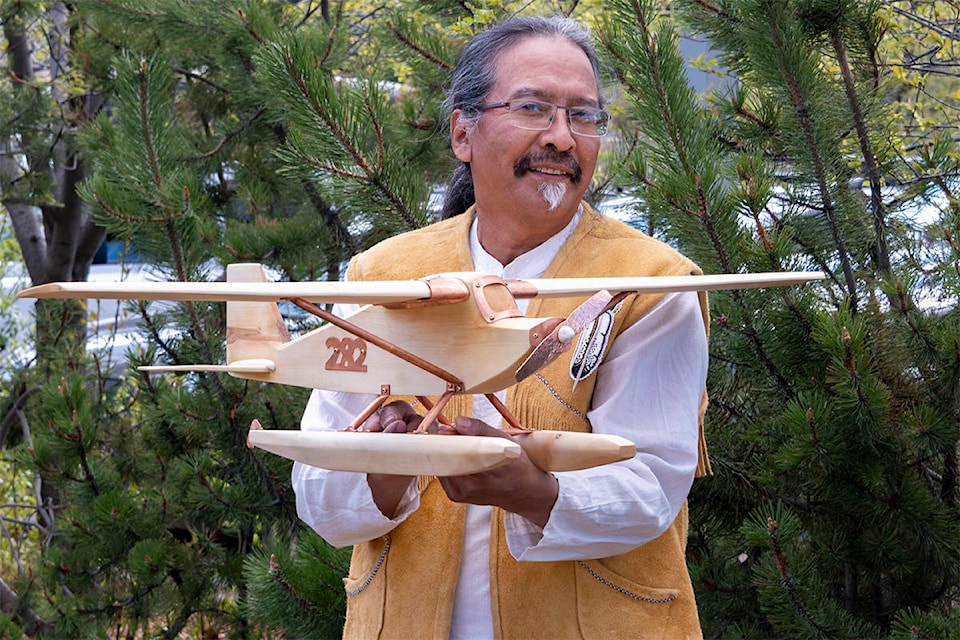Dennis Shorty is no stranger to the Yukon arts scene. He experimented with watercolour in last year’s exhibit, My Childhood Memories, and has two pieces in the Yukon permanent art collection.
The Yukon government has recently acquired a sculpture of a float plane as his third piece for the collection.
Shorty was eight years old when he started making sculptures. He used to watch his father carve toys for him and his siblings, and one was a float plane.
In 1963, a float plane came to Jackfish Lake near Ross River and took him to Watson Lake. He was five years old and his final destination was the residential school at Lower Post.
Engraved in his artwork are the letters LP and the number 282.
“The LP on there stands for Lower Post, and 282, that’s me, that’s who I was in mission school,” Shorty said. “That was my number.”
Shorty’s wooden float plane is one of five three-dimensional art pieces recently acquired by government for the collection.
Friends of the Yukon Permanent Art Collection reviewed 62 submissions from 32 artists.
The jury of nine, made up of artists, curators, art patrons and community members, was given $12,650 to select an array of three-dimensional artwork. The artists are paid for their work.
The call for submissions this year included jewelry, sculpture, carving and traditional sewing and beading. Judges selected pieces based on overall quality, originality and skill and relevance to the Yukon or the legacy of Yukon artists.
“When people tend to think of Yukon art, I think any sort of thing could come to your mind,” said Garnet Meuthing, art curator for the Department of Tourism and Culture.
“Whether you’re thinking back to Ted Harrison, who created a very iconic vision of the Yukon landscape, or traditional beadwork that reflects some of the flora and fauna happening here, or sculpture made out of local wood or antler.”
Shorty’s plane, which took four months to complete, holds an even deeper meaning.
“[It’s] symbolizing letting go of the pain for myself and whoever is looking at that piece, for them to let go too,” Shorty said.
Shorty spent seven years in residential school. The float plane would bring him home every summer, and come back for him in the fall.
“I was kind of excited when I first got to school because my brothers and sisters went, I figured I’ll be there with them too,” he said.
“But little did I know that they’d separate us, when we were in school, they won’t let us stay together as a family…. First thing I learned in there was to defend myself.”
His story mirrors the experiences of other residential school survivors. The first thing he remembers is being covered in white powder and getting a haircut, and someone from the school telling him to get in the shower and scrub.
“He grabbed me and he started scrubbing my hand (until) it started bleeding. He was trying to rub my skin off because it was brown. He thought it was dirty,” he said.
Lower Post Indian Residential School closed in 1975. One of the school’s supervisors, Jerzy George Maczynski, was charged with 28 counts of sexual abuse in the mid ‘90s.
Most of the school has been demolished, but the memories of years of abuse linger.
Shorty said he’s learned to forgive, but he can’t forget.
He hopes his float plane will help other residential school survivors heal, but he also wants the public to understand where survivors have come from and the impact it has had on generations of Indigenous people.
“It means a lot, not only for myself but for other artists, young artists, to strive forward, not to dwell in the past,” Shorty said.
“I can’t forget what happened to me, but I learn how to carry on through my artwork.”
All five artists selected this year are Indigenous, although Meuthing said that was not necessarily the intention. The five artists whose work will be on display are Dennis Shorty, Daniel Benjamin Gribben, Tamika Knutson, Teresa Vander Meer-Chassé and Lorraine Wolfe. The new acquisitions brings the permanent art collection to a total of 435 pieces.
“The purpose of the permanent collection is to reflect all of the art being created in the Yukon,” Meuthing said. “We’re bringing in expertise from many different areas to choose artwork that really reflects the community the best way that we can.”
The art collection rotates through the Yukon. Artwork is currently on display in Whitehorse, Dawson, Faro, Haines Junction and Mayo.
The new acquisitions will be unveiled this fall.
Contact Kallan Lyons at kallan.lyons@yukon-news.com
